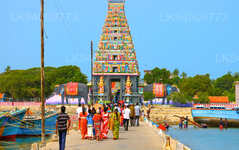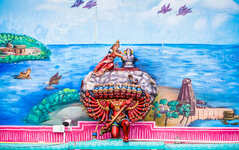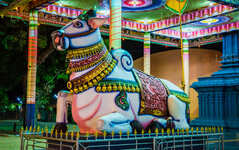
Jaffna City
Jaffna is the main city of Jaffna peninsula in the northernmost district of Sri Lanka. Comfortable intercity busses from Colombo take 10-12 hours to reach the city of Jaffna.
Nainativu Nagapooshani Amman-Tempel
Der Nainativu Nagapooshani Amman-Tempel ist ein alter und historischer Hindu-Tempel inmitten der Palk-Straße auf der Insel Nainativu in Sri Lanka. Es ist Parvati gewidmet, die als Nagapooshani oder Bhuvaneswari bekannt ist, und ihrer Gemahlin Shiva, die hier als Nayinaar bezeichnet wird. Der Ruhm des Tempels geht auf Adi Shankaracharya zurück, einen hinduistischen Philosophen aus dem 9. Jahrhundert, der ihn als einen der prominenten 64 Shakti Peethams im Shakti Peetha Stotram identifizierte und im Brahmanda Purana erwähnte. Der Tempelkomplex beherbergt vier Gopurams (Tortürme) mit einer Höhe von 20 bis 25 Fuß. Der höchste ist der östliche Raja Raja Gopuram mit einer Höhe von 108 Fuß. Der Tempel ist ein bedeutendes Symbol für das tamilische Volk und wird seit der Antike in tamilischer Literatur wie Manimekalai und Kundalakesi erwähnt. Das heutige Bauwerk wurde zwischen 1720 und 1790 erbaut, nachdem das antike Bauwerk 1620 von den Portugiesen zerstört worden war. Der Tempel zieht täglich etwa 1.000 Besucher und bei Festen etwa 5.000 Besucher an. Das jährliche 16-tägige Mahostavam (Thiruvizha)-Fest, das im tamilischen Monat Aani (Juni/Juli) gefeiert wird, zieht über 100.000 Pilger an. In diesem neu renovierten Tempel gibt es schätzungsweise 10.000 Skulpturen.
About Jaffna District
Jaffna is the capital city of the Northern Province, Sri Lanka. 85% of the populations of the Jaffna and Kilinochchi districts are Hindus. The Hindus follow the Saivite tradition. The remainders are largely Roman Catholics or Protestants, some of whom are descendants of colonial settlers, known as Burghers. The Tamils are divided along caste lines, with the farmer-caste Vellalar forming the majority. Sea products, red onion, and tobacco are the main products in Jaffna.
Jaffna is home to beautiful Hindu temples. An Old Dutch Fort still stands well preserved within which is an old Church. Another example of Dutch architecture is the King's House. No visit to Jaffna is complete without tasting the exquisite Jaffna mango, reputed for its sweetness. About 3 km away is the majestic Nallur Kandaswamy Temple, home to the largest religious festival in Jaffna. The Kayts Harbour is an ancient ship docking site in the Jaffna region.
About Northern Province
The Northern Province is one of the 9 provinces of Sri Lanka. The provinces have existed since the 19th century but they didn't have any legal status until 1987 when the 13th Amendment to the 1978 Constitution of Sri Lanka established provincial councils. Between 1988 and 2006 the province was temporarily merged with the Eastern Province to form the North-East Province. The capital of the province is Jaffna.
Northern Province is located in the north of Sri Lanka and is just 22 miles (35 km) from India. The province is surrounded by the Gulf of Mannar and Palk Bay to the west, Palk Strait to the north, the Bay of Bengal to the east and the Eastern, North Central and North Western provinces to the south.The province has a number of lagoons, the largest being Jaffna Lagoon, Nanthi Kadal, Chundikkulam Lagoon, Vadamarachchi Lagoon, Uppu Aru Lagoon, Kokkilai lagoon, Nai Aru Lagoon and Chalai Lagoon.Most of the islands around Sri Lanka are to be found to the west of the Northern Province. The largest islands are: Kayts, Neduntivu, Karaitivu, Pungudutivu and Mandativu.
The Northern Province's population was 1,311,776 in 2007. The majority of the populations are Sri Lankan Tamils, with a minority Sri Lankan Moor and Sinhalese population. Sri Lankan Tamil is the major language spoken in the province by the vast majority of the population. The other language spoken is Sinhala by 1 percent of the population. English is widely spoken and understood in the cities.




















